Superfluid helium-4
Superfluid helium-4 is the superfluid form of helium-4, an isotope of the element helium. A superfluid is a state of matter in which the matter behaves like a fluid with zero viscosity. The substance, which looks like a normal liquid, flows without friction past any surface, which allows it to continue to circulate over obstructions and through pores in containers which hold it, subject only to its own inertia.
Known as a major facet in the study of quantum hydrodynamics and macroscopic quantum phenomena, the superfluidity effect was discovered by Pyotr Kapitsa[1] and John F. Allen, and Don Misener[2] in 1937. It has since been described through phenomenological and microscopic theories. The formation of the superfluid is known to be related to the formation of a Bose–Einstein condensate. This is made obvious by the fact that superfluidity occurs in liquid helium-4 at far higher temperatures than it does in helium-3. Each atom of helium-4 is a boson particle, by virtue of its zero spin. Helium-3, however, is a fermion particle, which can form bosons only by pairing with itself at much lower temperatures, in a process similar to the electron pairing in superconductivity.[3]
In the 1950s, Hall and Vinen performed experiments establishing the existence of quantized vortex lines in superfluid helium.[4] In the 1960s, Rayfield and Reif established the existence of quantized vortex rings.[5] Packard has observed the intersection of vortex lines with the free surface of the fluid,[6] and Avenel and Varoquaux have studied the Josephson effect in superfluid helium-4.[7] In 2006 a group at the University of Maryland visualized quantized vortices by using small tracer particles of solid hydrogen.[8]
Properties
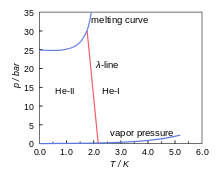

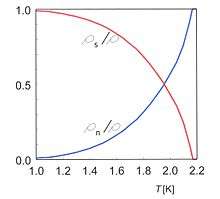
Figure 1 is the phase diagram of 4He.[9] It is a pressure-temperature (p-T) diagram indicating the solid and liquid regions separated by the melting curve (between the liquid and solid state) and the liquid and gas region, separated by the vapor-pressure line. This latter ends in the critical point where the difference between gas and liquid disappears. The diagram shows the remarkable property that 4He is liquid even at absolute zero. Helium four is only solid at pressures above 25 bar.
Figure 1 also shows the λ-line. This is the line that separates two fluid regions in the phase diagram indicated by He-I and He-II. In the He-I region the helium behaves like a normal fluid; in the He-II region the helium is superfluid.
The name lambda-line comes from the specific heat – temperature plot which has the shape of the Greek letter λ.[10][11] See figure 2, which shows a peak at 2.172 K, the so-called λ-point of 4He.
Below the lambda line the liquid can be described by the so-called two-fluid model. It behaves as if it consists of two components: a normal component, which behaves like a normal fluid, and a superfluid component with zero viscosity and zero entropy. The ratios of the respective densities ρn/ρ and ρs/ρ, with ρn (ρs) the density of the normal (superfluid) component, and ρ (the total density), depends on temperature and is represented in figure 3.[12] By lowering the temperature, the fraction of the superfluid density increases from zero at Tλ to one at zero kelvins. Below 1 K the helium is almost completely superfluid.
It is possible to create density waves of the normal component (and hence of the superfluid component since ρn + ρs = constant) which are similar to ordinary sound waves. This effect is called second sound. Due to the temperature dependence of ρn (figure 3) these waves in ρn are also temperature waves.


Film flow
Many ordinary liquids, like alcohol or petroleum, creep up solid walls, driven by their surface tension. Liquid helium also has this property, but, in the case of He-II, the flow of the liquid in the layer is not restricted by its viscosity but by a critical velocity which is about 20 cm/s. This is a fairly high velocity so superfluid helium can flow relatively easily up the wall of containers, over the top, and down to the same level as the surface of the liquid inside the container, in a siphon effect as illustrated in figure 4. In a container, lifted above the liquid level, it forms visible droplets as seen in figure 5. It was, however, observed, that the flow through nanoporous membrane becomes restricted if the pore diameter is less than 0.7 nm (i.e. roughly three times the classical diameter of helium atom), suggesting the unusual hydrodynamic properties of He arise at larger scale than in the classical liquid helium [13].
Superfluid hydrodynamics
The equation of motion for the superfluid component, in a somewhat simplified form,[14] is given by Newton's law
The mass M4 is the molar mass of 4He and is the velocity of the superfluid component. The time derivative is the so-called hydrodynamic derivative, i.e. the rate of increase of the velocity when moving with the fluid. In the case of superfluid 4He in the gravitational field the force is given by[15][16]
- .
In this expression μ is the molar chemical potential, g the gravitational acceleration, and z the vertical coordinate. Thus we get
-
(1)
Eq.(1) only holds if vs is below a certain critical value which usually is determined by the diameter of the flow channel.[17][18]
In classical mechanics the force is often the gradient of a potential energy. Eq.(1) shows that, in the case of the superfluid component, the force contains a term due to the gradient of the chemical potential. This is the origin of the remarkable properties of He-II such as the fountain effect.
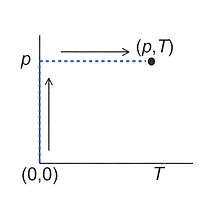
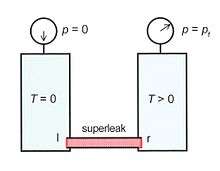
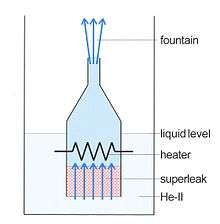
Fountain pressure
In order to rewrite Eq.(1) in more familiar form we use the general formula
-
(2)
Here Sm is the molar entropy and Vm the molar volume. With Eq.(2) μ(p,T) can be found by a line integration in the p-T plane. First we integrate from the origin (0,0) to (p,0), so at T =0. Next we integrate from (p,0) to (p,T), so with constant pressure (see figure 6). In the first integral dT=0 and in the second dp=0. With Eq.(2) we obtain
-
(3)
We are interested only in cases where p is small so that Vm is practically constant. So
-
(4)
where Vm0 is the molar volume of the liquid at T =0 and p =0. The other term in Eq.(3) is also written as a product of Vm0 and a quantity pf which has the dimension of pressure
-
(5)
The pressure pf is called the fountain pressure. It can be calculated from the entropy of 4He which, in turn, can be calculated from the heat capacity. For T =Tλ the fountain pressure is equal to 0.692 bar. With a density of liquid helium of 125 kg/m3 and g = 9.8 m/s2 this corresponds with a liquid-helium column of 56 meter height. So, in many experiments, the fountain pressure has a bigger effect on the motion of the superfluid helium than gravity.
With Eqs.(4) and (5), Eq.(3) obtains the form
-
(6)
Substitution of Eq.(6) in (1) gives
-
(7)
with ρ₀ = M4/Vm0 the density of liquid 4He at zero pressure and temperature.
Eq.(7) shows that the superfluid component is accelerated by gradients in the pressure and in the gravitational field, as usual, but also by a gradient in the fountain pressure.
So far Eq.(5) has only mathematical meaning, but in special experimental arrangements pf can show up as a real pressure. Figure 7 shows two vessels both containing He-II. The left vessel is supposed to be at zero kelvins (Tl=0) and zero pressure (pl = 0). The vessels are connected by a so-called superleak. This is a tube, filled with a very fine powder, so the flow of the normal component is blocked. However, the superfluid component can flow through this superleak without any problem (below a critical velocity of about 20 cm/s). In the steady state vs=0 so Eq.(7) implies
-
(8)
where the index l (r) applies to the left (right) side of the superleak. In this particular case pl = 0, zl = zr, and pfl = 0 (since Tl = 0). Consequently,
This means that the pressure in the right vessel is equal to the fountain pressure at Tr.
In an experiment, arranged as in figure 8, a fountain can be created. The fountain effect is used to drive the circulation of 3He in dilution refrigerators.[19][20]
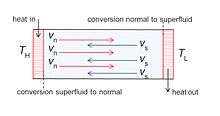
Heat transport
Figure 9 depicts a heat-conduction experiment between two temperatures TH and TL connected by a tube filled with He-II. When heat is applied to the hot end a pressure builds up at the hot end according to Eq.(7). This pressure drives the normal component from the hot end to the cold end according to
-
(9)
Here ηn is the viscosity of the normal component,[21] Z some geometrical factor, and the volume flow. The normal flow is balanced by a flow of the superfluid component from the cold to the hot end. At the end sections a normal to superfluid conversion takes place and vice versa. So heat is transported, not by heat conduction, but by convection. This kind of heat transport is very effective, so the thermal conductivity of He-II is very much better than the best materials. The situation is comparable with heat pipes where heat is transported via gas–liquid conversion. The high thermal conductivity of He-II is applied for stabilizing superconducting magnets such as in the Large Hadron Collider at CERN.
Theory
Landau two-fluid approach
L. D. Landau's phenomenological and semi-microscopic theory of superfluidity of helium-4 earned him the Nobel Prize in physics, in 1962. Assuming that sound waves are the most important excitations in helium-4 at low temperatures, he showed that helium-4 flowing past a wall would not spontaneously create excitations if the flow velocity was less than the sound velocity. In this model, the sound velocity is the "critical velocity" above which superfluidity is destroyed. (Helium-4 actually has a lower flow velocity than the sound velocity, but this model is useful to illustrate the concept.) Landau also showed that the sound wave and other excitations could equilibrate with one another and flow separately from the rest of the helium-4, which is known as the "condensate".
From the momentum and flow velocity of the excitations he could then define a "normal fluid" density, which is zero at zero temperature and increases with temperature. At the so-called Lambda temperature, where the normal fluid density equals the total density, the helium-4 is no longer superfluid.
To explain the early specific heat data on superfluid helium-4, Landau posited the existence of a type of excitation he called a "roton", but as better data became available he considered that the "roton" was the same as a high momentum version of sound.
The Landau theory does not elaborate on the microscopic structure of the superfluid component of liquid helium. The first attempt to create the microscopic theory of the superfluid component itself was done by London.[22] and Tisza[23][24] Subsequently, other microscopical models were proposed by different authors. Their main objective is to derive the form of the inter-particle potential between helium atoms in superfluid state from first principles of quantum mechanics. To date, a number of models of this kind have been proposed: models with vortex rings, hard-sphere models, Gaussian cluster theories, etc.
Vortex ring model
Landau thought that vorticity entered superfluid helium-4 by vortex sheets, but such sheets have since been shown to be unstable. Lars Onsager and, later independently, Feynman showed that vorticity enters by quantized vortex lines. They also developed the idea of quantum vortex rings. Arie Bijl in the 1940s,[25] and Richard Feynman around 1955,[26] developed microscopic theories for the roton, which was shortly observed with inelastic neutron experiments by Palevsky. Later on, Feynman admitted that his model gives only qualitative agreement with experiment.[27][28]
Hard-sphere models
The models are based on the simplified form of the inter-particle potential between helium-4 atoms in the superfluid phase. Namely, the potential is assumed to be of the hard-sphere type.[29][30][31] In these models the famous Landau (roton) spectrum of excitations is qualitatively reproduced.
Gaussian cluster approach
This is a two-scale approach which describes the superfluid component of liquid helium-4. It consists of two nested models linked via parametric space. The short-wavelength part describes the interior structure of the fluid element using a non-perturbative approach based on the Logarithmic Schrödinger equation; it suggests the Gaussian-like behaviour of the element's interior density and interparticle interaction potential. The long-wavelength part is the quantum many-body theory of such elements which deals with their dynamics and interactions. The approach provides a unified description of the phonon, maxon and roton excitations, and has noteworthy agreement with experiment: with one essential parameter to fit one reproduces at high accuracy the Landau roton spectrum, sound velocity and structure factor of superfluid helium-4.[32] This model utilizes the general theory of quantum Bose liquids with logarithmic nonlinearities[33] which is based on introducing a dissipative-type contribution to energy related to the quantum Everett-Hirschman entropy function.[34][35]
Background
Although the phenomenologies of the superfluid states of helium-4 and helium-3 are very similar, the microscopic details of the transitions are very different. Helium-4 atoms are bosons, and their superfluidity can be understood in terms of the Bose–Einstein statistics that they obey. Specifically, the superfluidity of helium-4 can be regarded as a consequence of Bose-Einstein condensation in an interacting system. On the other hand, helium-3 atoms are fermions, and the superfluid transition in this system is described by a generalization of the BCS theory of superconductivity. In it, Cooper pairing takes place between atoms rather than electrons, and the attractive interaction between them is mediated by spin fluctuations rather than phonons. (See fermion condensate.) A unified description of superconductivity and superfluidity is possible in terms of gauge symmetry breaking.
Superfluids, such as helium-4 below the lambda point, exhibit many unusual properties. (See Helium#Helium II state). A superfluid acts as if it were a mixture of a normal component, with all the properties of a normal fluid, and a superfluid component. The superfluid component has zero viscosity and zero entropy. Application of heat to a spot in superfluid helium results in a flow of the normal component which takes care of the heat transport at relatively high velocity (up to 20 cm/s) which leads to a very high effective thermal conductivity.
Another fundamental property becomes visible if a superfluid is placed in a rotating container. Instead of rotating uniformly with the container, the rotating state consists of quantized vortices. That is, when the container is rotated at speeds below the first critical angular velocity, the liquid remains perfectly stationary. Once the first critical angular velocity is reached, the superfluid will form a vortex. The vortex strength is quantized, that is, a superfluid can only spin at certain "allowed" values. Rotation in a normal fluid, like water, is not quantized. If the rotation speed is increased more and more quantized vortices will be formed which arrange in nice patterns similar to the Abrikosov lattice in a superconductor.
Practical application
Recently in the field of chemistry, superfluid helium-4 has been successfully used in spectroscopic techniques as a quantum solvent. Referred to as superfluid helium droplet spectroscopy (SHeDS), it is of great interest in studies of gas molecules, as a single molecule solvated in a superfluid medium allows a molecule to have effective rotational freedom, allowing it to behave similarly to how it would in the "gas" phase. Droplets of superfluid helium also have a characteristic temperature of about 0.4 K which cools the solvated molecule(s) to its ground or nearly ground rovibronic state.
Superfluids are also used in high-precision devices such as gyroscopes, which allow the measurement of some theoretically predicted gravitational effects (for an example, see Gravity Probe B).
In 1999, one type of superfluid was used to trap light and greatly reduce its speed. In an experiment performed by Lene Hau, light was passed through a Bose-Einstein condensed gas of sodium (analogous to a superfluid) and found to be slowed to 17 metres per second (61 km/h) from its normal speed of 299,792,458 metres per second in vacuum.[36] This does not change the absolute value of c, nor is it completely new: any medium other than vacuum, such as water or glass, also slows down the propagation of light to c/n where n is the material's refractive index. The very slow speed of light and high refractive index observed in this particular experiment, moreover, is not a general property of all superfluids.
The Infrared Astronomical Satellite IRAS, launched in January 1983 to gather infrared data was cooled by 73 kilograms of superfluid helium, maintaining a temperature of 1.6 K (−271.55 °C). Furthermore, when used in conjunction with helium-3, temperatures as low as 40 mK are routinely achieved in extreme low temperature experiments. The helium-3, in liquid state at 3.2 K, can be evaporated into the superfluid helium-4, where it acts as a gas due to the latter's properties as a Bose-Einstein condensate. This evaporation pulls energy from the overall system, which can be pumped out in a way completely analogous to normal refrigeration techniques.
Superfluid-helium technology is used to extend the temperature range of cryocoolers to lower temperatures. So far the limit is 1.19 K, but there is a potential to reach 0.7 K.[37]
21st-century developments
In the early 2000s, physicists created a Fermionic condensate from pairs of ultra-cold fermionic atoms. Under certain conditions, fermion pairs form diatomic molecules and undergo Bose–Einstein condensation. At the other limit, the fermions (most notably superconducting electrons) form Cooper pairs which also exhibit superfluidity. This work with ultra-cold atomic gases has allowed scientists to study the region in between these two extremes, known as the BEC-BCS crossover.
Supersolids may also have been discovered in 2004 by physicists at Penn State University. When helium-4 is cooled below about 200 mK under high pressures, a fraction (~1%) of the solid appears to become superfluid.[38][39] By quench cooling or lengthening the annealing time, thus increasing or decreasing the defect density respectively, it was shown, via torsional oscillator experiment, that the supersolid fraction could be made to range from 20% to completely non-existent. This suggested that the supersolid nature of helium-4 is not intrinsic to helium-4 but a property of helium-4 and disorder.[40][41] Some emerging theories posit that the supersolid signal observed in helium-4 was actually an observation of either a superglass state[42] or intrinsically superfluid grain boundaries in the helium-4 crystal.[43]
See also
References
- ↑ Kapitza, P. (1938). "Viscosity of Liquid Helium Below the λ-Point". Nature. 141 (3558): 74. Bibcode:1938Natur.141...74K. doi:10.1038/141074a0.
- ↑ Allen, J. F.; Misener, A. D. (1938). "Flow of Liquid Helium II". Nature. 142 (3597): 643. Bibcode:1938Natur.142..643A. doi:10.1038/142643a0.
- ↑ "The Nobel Prize in Physics 1996 - Advanced Information". www.nobelprize.org. Retrieved 2017-02-10.
- ↑ Hall, H. E.; Vinen, W. F. (1956). "The Rotation of Liquid Helium II. II. The Theory of Mutual Friction in Uniformly Rotating Helium II". Proceedings of the Royal Society A: Mathematical, Physical and Engineering Sciences. 238 (1213): 215. Bibcode:1956RSPSA.238..215H. doi:10.1098/rspa.1956.0215.
- ↑ Rayfield, G.; Reif, F. (1964). "Quantized Vortex Rings in Superfluid Helium". Physical Review. 136 (5A): A1194. Bibcode:1964PhRv..136.1194R. doi:10.1103/PhysRev.136.A1194.
- ↑ Packard, Richard E. (1982). "Vortex photography in liquid helium". Physica B+C. 109–110: 1474. Bibcode:1982PhyBC.109.1474P. doi:10.1016/0378-4363(82)90510-1.
- ↑ Avenel, O.; Varoquaux, E. (1985). "Observation of Singly Quantized Dissipation Events Obeying the Josephson Frequency Relation in the Critical Flow of Superfluid ^{4}He through an Aperture" (PDF). Physical Review Letters. 55 (24): 2704–2707. Bibcode:1985PhRvL..55.2704A. PMID 10032216. doi:10.1103/PhysRevLett.55.2704.
- ↑ Bewley, Gregory P.; Lathrop, Daniel P.; Sreenivasan, Katepalli R. (2006). "Superfluid helium: Visualization of quantized vortices" (PDF). Nature. 441 (7093): 588. Bibcode:2006Natur.441..588B. PMID 16738652. doi:10.1038/441588a.
- ↑ Swenson, C. (1950). "The Liquid-Solid Transformation in Helium near Absolute Zero". Physical Review. 79 (4): 626. Bibcode:1950PhRv...79..626S. doi:10.1103/PhysRev.79.626.
- ↑ Keesom, W.H.; Keesom, A.P. (1935). "New measurements on the specific heat of liquid helium". Physica. 2: 557. Bibcode:1935Phy.....2..557K. doi:10.1016/S0031-8914(35)90128-8.
- ↑ Buckingham, M.J.; Fairbank, W.M. (1961). "Chapter III The Nature of the λ-Transition in Liquid Helium". The nature of the λ-transition in liquid helium. Progress in Low Temperature Physics. 3. p. 80. ISBN 978-0-444-53309-8. doi:10.1016/S0079-6417(08)60134-1.
- ↑ E.L. Andronikashvili Zh. Éksp. Teor. Fiz, Vol.16 p.780 (1946), Vol.18 p. 424 (1948)
- ↑ https://www.nature.com/articles/srep28992
- ↑ S.J. Putterman, Superfluid Hydrodynamics (North-Holland Publishing Company, Amsterdam, 1974) ISBN 0-444-10681-2
- ↑ L.D. Landau, J. Phys. USSR, Vol.5 (1941) p.71.
- ↑ I.M. Khalatnikov, An introduction to the theory of superfluidity (W.A. Benjamin, Inc., New York, 1965) ISBN 0-7382-0300-9.
- ↑ Van Alphen, W.M.; Van Haasteren, G.J.; De Bruyn Ouboter, R.; Taconis, K.W. (1966). "The dependence of the critical velocity of the superfluid on channel diameter and film thickness". Physics Letters. 20 (5): 474. Bibcode:1966PhL....20..474V. doi:10.1016/0031-9163(66)90958-9.
- ↑ De Waele, A.Th.A.M.; Kuerten, J.G.M. (1992). "Chapter 3: Thermodynamics and Hydrodynamics of 3He-4He Mixtures". Thermodynamics and hydrodynamics of 3He-4He mixtures. Progress in Low Temperature Physics. 13. p. 167. ISBN 978-0-444-89109-9. doi:10.1016/S0079-6417(08)60052-9.
- ↑ Staas, F.A.; Severijns, A.P.; Van Der Waerden, H.C.M. (1975). "A dilution refrigerator with superfluid injection". Physics Letters A. 53 (4): 327. Bibcode:1975PhLA...53..327S. doi:10.1016/0375-9601(75)90087-0.
- ↑ Castelijns, C.; Kuerten, J.; De Waele, A.; Gijsman, H. (1985). "3He flow in dilute 3He-4He mixtures at temperatures between 10 and 150 mK". Physical Review B. 32 (5): 2870. Bibcode:1985PhRvB..32.2870C. doi:10.1103/PhysRevB.32.2870.
- ↑ J.C.H. Zeegers Critical velocities and mutual friction in 3He-4He mixtures at low temperatures below 100 mK', thesis, Appendix A, Eindhoven University of Technology, 1991.
- ↑ F. London (1938). "The λ-Phenomenon of Liquid Helium and the Bose-Einstein Degeneracy". Nature. 141 (3571): 643–644. Bibcode:1938Natur.141..643L. doi:10.1038/141643a0.
- ↑ L. Tisza (1938). "Transport Phenomena in Helium II". Nature. 141 (3577): 913. Bibcode:1938Natur.141..913T. doi:10.1038/141913a0.
- ↑ L. Tisza (1947). "The Theory of Liquid Helium". Phys. Rev. 72 (9): 838–854. Bibcode:1947PhRv...72..838T. doi:10.1103/PhysRev.72.838.
- ↑ Bijl, A; de Boer, J; Michels, A (1941). "Properties of liquid helium II". Physica. 8 (7): 655–675. Bibcode:1941Phy.....8..655B. doi:10.1016/S0031-8914(41)90422-6.
- ↑ Braun, L. M., ed. (2000). Selected papers of Richard Feynman with commentary. World Scientific Series in 20th century Physics. 27. World Scientific. ISBN 978-9810241315. Section IV (pages 313 to 414) deals with liquid helium.
- ↑ R. P. Feynman (1954). "Atomic Theory of the Two-Fluid Model of Liquid Helium". Phys. Rev. 94 (2): 262. Bibcode:1954PhRv...94..262F. doi:10.1103/PhysRev.94.262.
- ↑ R. P. Feynman & M. Cohen (1956). "Energy Spectrum of the Excitations in Liquid Helium". Phys. Rev. 102 (5): 1189–1204. Bibcode:1956PhRv..102.1189F. doi:10.1103/PhysRev.102.1189.
- ↑ T. D. Lee; K. Huang & C. N. Yang (1957). "Eigenvalues and Eigenfunctions of a Bose System of Hard Spheres and Its Low-Temperature Properties". Phys. Rev. 106 (6): 1135–1145. Bibcode:1957PhRv..106.1135L. doi:10.1103/PhysRev.106.1135.
- ↑ L. Liu; L. S. Liu & K. W. Wong (1964). "Hard-Sphere Approach to the Excitation Spectrum in Liquid Helium II". Phys. Rev. 135 (5A): A1166–A1172. Bibcode:1964PhRv..135.1166L. doi:10.1103/PhysRev.135.A1166.
- ↑ A. P. Ivashin & Y. M. Poluektov (2011). "Short-wave excitations in non-local Gross-Pitaevskii model". Cent. Eur. J. Phys. 9 (3): 857–864. Bibcode:2010CEJPh.tmp..120I. doi:10.2478/s11534-010-0124-7.
- ↑ K. G. Zloshchastiev (2012). "Volume element structure and roton-maxon-phonon excitations in superfluid helium beyond the Gross-Pitaevskii approximation". Eur. Phys. J. B. 85 (8): 273. Bibcode:2012EPJB...85..273Z. arXiv:1204.4652
 . doi:10.1140/epjb/e2012-30344-3.
. doi:10.1140/epjb/e2012-30344-3. - ↑ A. V. Avdeenkov & K. G. Zloshchastiev (2011). "Quantum Bose liquids with logarithmic nonlinearity: Self-sustainability and emergence of spatial extent". J. Phys. B: At. Mol. Opt. Phys. 44 (19): 195303. Bibcode:2011JPhB...44s5303A. arXiv:1108.0847
 . doi:10.1088/0953-4075/44/19/195303.
. doi:10.1088/0953-4075/44/19/195303. - ↑ Hugh Everett, III. The Many-Worlds Interpretation of Quantum Mechanics: the theory of the universal wave function. Everett's Dissertation
- ↑ I.I. Hirschman, Jr., A note on entropy. American Journal of Mathematics (1957) pp. 152–156
- ↑ Hau, Lene Vestergaard; Harris, S. E.; Dutton, Zachary; Behroozi, Cyrus H. (1999). "Light speed reduction to 17 metres per second in an ultracold atomic gas" (PDF). Nature. 397 (6720): 594. Bibcode:1999Natur.397..594V. doi:10.1038/17561.
- ↑ Tanaeva, I. A. (2004). "Superfluid Vortex Cooler". AIP Conference Proceedings. 710. p. 1906. doi:10.1063/1.1774894.
- ↑ E. Kim and M. H. W. Chan (2004). "Probable Observation of a Supersolid Helium Phase". Nature. 427 (6971): 225–227. Bibcode:2004Natur.427..225K. PMID 14724632. doi:10.1038/nature02220.
- ↑ Moses Chan's Research Group. "Supersolid." Penn State University, 2004.
- ↑ Sophie, A; Rittner C (2006). "Observation of Classical Rotational Inertia and Nonclassical Supersolid Signals in Solid 4 He below 250 mK". Phys. Rev. Lett. 97 (16): 165301. Bibcode:2006PhRvL..97p5301R. PMID 17155406. doi:10.1103/PhysRevLett.97.165301.
- ↑ Sophie, A; Rittner C (2007). "Disorder and the Supersolid State of Solid 4 He". Phys. Rev. Lett. 98 (17): 175302. Bibcode:2007PhRvL..98q5302R. arXiv:cond-mat/0702665
 . doi:10.1103/PhysRevLett.98.175302.
. doi:10.1103/PhysRevLett.98.175302. - ↑ Boninsegni, M; Prokofev (2006). "Superglass Phase of 4 He". Phys. Rev. Lett. 96 (13): 135301. PMID 16711998. doi:10.1103/PhysRevLett.96.135301.
- ↑ Pollet, L; Boninsegni M (2007). "Superfuididty of Grain Boundaries in Solid 4 He". Phys. Rev. Lett. 98 (13): 135301. Bibcode:2007PhRvL..98m5301P. PMID 17501209. arXiv:cond-mat/0702159
 . doi:10.1103/PhysRevLett.98.135301.
. doi:10.1103/PhysRevLett.98.135301.
Further reading
- London, F. Superfluids (Wiley, New York, 1950)
- D.R. Tilley and J. Tilley, ``Superfluidity and Superconductivity, (IOP Publishing Ltd., Bristol, 1990)
- Hagen Kleinert, Gauge Fields in Condensed Matter, Vol. I, "SUPERFLOW AND VORTEX LINES", pp. 1–742, World Scientific (Singapore, 1989); Paperback ISBN 9971-5-0210-0 (also available online)
- Antony M. Guénault: Basic superfluids. Taylor & Francis, London 2003, ISBN 0-7484-0891-6
- James F. Annett: Superconductivity, superfluids, and condensates. Oxford Univ. Press, Oxford 2005, ISBN 978-0-19-850756-7
- Leggett, A. (1999). "Superfluidity". Reviews of Modern Physics. 71 (2): S318–S323. Bibcode:1999RvMPS..71..318L. doi:10.1103/RevModPhys.71.S318.
- Philippe Lebrun & Laurent Tavian: The technology of superfluid helium
External links
- Rousseau, V. G. (2014). "Superfluid density in continuous and discrete spaces: Avoiding misconceptions". Physical Review B. 90 (13). doi:10.1103/PhysRevB.90.134503.
- Liquid Helium II,Superfluid:demonstrations of Lambda point transition/viscosity paradox /two fluid model/fountain effect/creeping film/ second sound.
- Video including superfluid helium's strange behavior
- Superfluid phases of helium
- https://web.archive.org/web/20060408121158/http://www.aip.org/pt/vol-54/iss-2/p31.html
- http://web.mit.edu/newsoffice/2005/matter.html
- superfluid hydrodynamics
- The Hindu article on superfluid states
